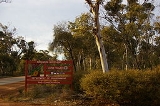
Dryandra Woodland
Encyclopedia
The Dryandra Woodland is a nature conservation area in Western Australia
within the Shires of Cuballing
, Williams
and Wandering
, about 164 kilometres (102 mi) south-east of Perth
and 22 kilometres (14 mi) north-west of the town of Narrogin
. It is a complex of 17 distinct blocks managed by the Western Australian Department of Environment and Conservation and spread over approximately 50 kilometres (30 mi) separated by areas of agricultural land. The area is considered to be one of the state's major conservation areas, and although it is far from pristine due to its history of logging operations, a number of species of threatened fauna are rebuilding populations through the removal of introduced predators such as fox
es and feral cat
s.
The combined area of the Woodland is 28,066 hectares (108.36 mi²), with individual blocks ranging in size from 87 hectares (0.34 mi²) to 12,283 hectares (47.43 mi²). Part of Dryandra Woodland is listed on the Register of the National Estate
by the Australian Heritage Council
.
In addition to the area's use as a wildlife refuge, it has anthropological significance with the indigenous Noongar
people having strong cultural links there.

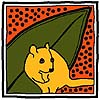 The Dryandra Woodland is found within the south-western province of the Yilgarn craton
The Dryandra Woodland is found within the south-western province of the Yilgarn craton
, "an ancient plateau composed mainly of granite
, with intrusions of dolerite and capped with laterite
. Past weathering of the plateau in the Dryandra area has produced a gently undulating countryside".
The Woodland lies close to the boundary between the Mallee
and Avon Wheatbelt
biogeographic
regions of the Southwest Botanical Province. It is situated on the western edge of the state's wheatbelt region: the area is a rare remnant of the open eucalypt
woodlands which covered much of the wheatbelt prior to land clearing which started from the 1890s. Dryandra's flora is transitional between that of the moister jarrah forest (generally to the south) and the semi-arid wheatbelt (to the east). It is known particularly for its extensive stands of Wandoo (Eucalyptus wandoo
), Powderbark Wandoo (E. accedens
) and Salmon White Gum (E. lane-poolei), and provides a haven for native flora and fauna while much of the surrounding country is badly affected by salinity
. Stands of Jarrah (E. marginata) and Marri (Corymbia calophylla
) provide additional top cover, and the understorey contains Rock Sheoak (Allocasuarina huegeliana
) and extensive areas of Banksia ser. Dryandra. Until early 2007 this latter shrub was classified as a separate genus
Dyrandra after which the Woodland is named. Species include Golden Dryandra (Banksia nobilis
) and Prickly Dryandra (B. armata
). An arboretum
on Tomingley Road holds a range of Australian native plants.
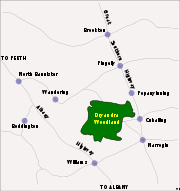 The 17 lots are surrounded by a largely cleared and agricultural landscape. In some cases, road reserves and other linking corridors of uncleared vegetation remain between the woodland islands. Some neighbouring landowners have revegetated areas of previously cleared private land to form additional corridors between these remnants. For certain animals, movement between blocks is necessary on a daily, seasonal or intermittent basis, to provide access to food, shelter, breeding sites and partners.
The 17 lots are surrounded by a largely cleared and agricultural landscape. In some cases, road reserves and other linking corridors of uncleared vegetation remain between the woodland islands. Some neighbouring landowners have revegetated areas of previously cleared private land to form additional corridors between these remnants. For certain animals, movement between blocks is necessary on a daily, seasonal or intermittent basis, to provide access to food, shelter, breeding sites and partners.
Threatened fauna receive extra protection within the 'Barna Mia' animal sanctuary, which is open to visitors by appointment for nocturnal tours on alternate evenings. Native marsupial
fauna include the Woylie
(Bettongia penicillata), Bilby
(Macrotis lagotis), Mala
(Lagorchestes hirsutus), Boodie
(Bettongia lesueur), and Marl (or Western Barred Bandicoot
: Perameles bougainville). The Quenda (or Southern Brown Bandicoot
: Isoodon obesulus) is locally extinct but may be reintroduced.
 The Woodland's position on the transition zone between the wheatbelt and the jarrah forest determines amphibian populations, with several species existing at the eastern or western limits of their range. Herpetofauna includes the Western Marsh Frog
The Woodland's position on the transition zone between the wheatbelt and the jarrah forest determines amphibian populations, with several species existing at the eastern or western limits of their range. Herpetofauna includes the Western Marsh Frog
(or Golden Flecked Burrowing Frog, Heleioporus barycragus) which is generally restricted to the western Darling Range. There are at least 98 species of bird in the Woodland, including the almost flightless Malleefowl
(Leipoa ocellata).
Climatically, Dryandra is described as semi-arid, with a warm, dry, Mediterranean climate
. It has seven to eight dry months each year with an annual average rainfall of about 500 millimetres (20 in). Seasonal changes in temperature, rainfall and wind direction are marked and more extreme than coastal areas of the south-west. The wettest months are May through September when about 70% of the annual rainfall occurs. Mean daily maximum temperatures are 30.9 °C (87.6 °F) in January and the mean daily minimum of 5.6 °C (42.1 °F) is in August.
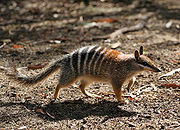 The following fauna are known to be living in the Woodland and have a conservation status of 'threatened' as recorded in the IUCN Red List
The following fauna are known to be living in the Woodland and have a conservation status of 'threatened' as recorded in the IUCN Red List
:
Major populations of three nationally endangered species exist in the woodlands: the woylie, the red tailed phascogale, and over 50 percent of the total known population of numbat.
Over 800 native flora have been identified within the Dryandra Woodland, including 15 that have been declared priority species under the Department of Environment and Conservation's Declared Rare and Priority Flora List. The conservation codes of P2 thru P4 are for flora that are considered rare but have some populations in areas where they are thought not be under immediate threat; higher numbers denote a lower threat level.
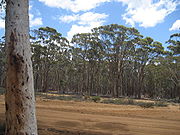 In the early 1900s a significant industry established within the forest and surrounding region harvesting bark
In the early 1900s a significant industry established within the forest and surrounding region harvesting bark
from Brown Mallet trees (Eucalyptus astringens), a species of eucalypt which grows on and near laterite
soils in parts of the southern wheatbelt. Bark sent to Germany for analysis was found to contain more than 40% of high quality, water-soluble tannin
s suitable for the production of quality leather by the process of tanning
.
By the mid 1920s, concerns were being raised about the ability of the area to maintain the supply of naturally grown mallet and by 1929, stands of the naturally grown mallet had almost disappeared. So, between 1925 and 1962 mallet plantations were established under the management of the Forestry Department which, during the Depression
, provided employment for sustenance workers who planted some 4,000 hectares (9,900 acres) of mallet, starting near 'Lol Gray' lookout. In 1933, 50 forestry workers were employed in the plantations. Seven steam trains and a sawmill
supported the industry within the Woodland. Two dams - 'Lol Gray' and the 'Old Mill Dam' provided good quality water to run the trains, as well as domestic water supplies which were carted by train to nearby towns including Narrogin.
Mallet bark was exported in ground form and was handled by a number of Fremantle
exporters, notably Henry Will & Co., Rosenstamms and Joyce Bros. Production after 1959 declined rapidly, coinciding with a world glut, increased royalty and production costs, and increased competition from synthetic tannins. The industry had effectively collapsed by the early 1960s.
Replanted forests now extend over approximately 30%, or 8,300 hectares (32 mi²), of Dryandra. Harvesting from plantation areas for timber production continues today under the Department of Environment and Conservation's management plan, which includes a vision for the area over the next 100 years. Conservation studies have shown that the managed harvesting will have no detrimental impact on the fauna habitat.
In 1960, Arthur Hunter, a local farmer, started manufacturing tool handles from naturally fallen and low-grade felled Wandoo and Mallet. This cottage industry has now expanded to produce over 100,000 tool handles each year. As well as tool handles, fencing materials and cutting of firewood for domestic use provide local employment.
occupied the southwest of the state for at least the past 40,000 years. In more recent times, thirteen different clans lived in the region. Collectively, the clans were known as Noongar
s and the people of the Dryandra area were from the Wiilman clan.
The Noongar people have strong cultural links with Dryandra which was known as Wilgadjny. Within the complex, five important archaeological sites have been identified to date, including an ochre
pit which was used for body decoration and rock art
. One Noongar born in 1910 described the ochre pit as being "a very spirity place" and somewhere to be avoided at night. Other known sites include artefact scatters, stone arrangements and a scarred tree, however the Woodland has not yet been fully surveyed for significant Aboriginal sites.
Following requests from local Indigenous people, the Department of Environment and Conservation is considering the feasibility of permitting some cultural activities including hunting and camping within the Woodland in order to pass on skills to younger members of that community. If permitted, such activities would need to be managed on a sustainable basis to ensure that the conservation goals of the Woodland are not compromised.
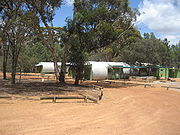 Almost all of the land within the complex today was classified as 'State Forest' in 1903 as an area for the protection of water catchments and growing wandoo and mallet forests.
Almost all of the land within the complex today was classified as 'State Forest' in 1903 as an area for the protection of water catchments and growing wandoo and mallet forests.
In 1962, a sub-committee of the Western Australian branch of the Australian Academy of Science
made recommendations which were reviewed in 1972 and 1974 by the Environmental Protection Authority of Western Australia
. In summary, the recommendations were:
The recommendations were endorsed by State Cabinet in 1976. Since that time, Dryandra has been managed principally as a nature reserve but also for limited commercial operations related to plantation timber.
In 1995, a management plan was prepared by CALM (now known as the Department of Environment and Conservation) for the Lands and Forest Commission who hold tenure over the State Forests which form the Woodland. The plan recommended (amongst other things) that the entire area be referred to officially as 'Dryandra Woodland' rather than as various State forests in recognition of its structural difference with the taller and denser forests of the Darling Range. Previously, a smaller section had been referred to as 'Dryandra', with other sections known by their various forestry names.
The principal objectives of the plan were:
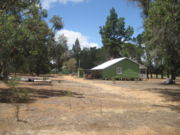 Dryandra Woodland attracts approximately 30,000 visitors per annum, including 5,000 overnight visits at the Dryandra campsite and settlement within the complex. Accommodation is available at the Congelin Camping Ground located near Congelin Dam and at the Lions Dryandra Village which uses restored cottages from the 1920s Forests Department settlement. Adjacent to the cottages is the Currawong Complex which has several Nissen hut
Dryandra Woodland attracts approximately 30,000 visitors per annum, including 5,000 overnight visits at the Dryandra campsite and settlement within the complex. Accommodation is available at the Congelin Camping Ground located near Congelin Dam and at the Lions Dryandra Village which uses restored cottages from the 1920s Forests Department settlement. Adjacent to the cottages is the Currawong Complex which has several Nissen hut
s acquired from an air force base and now used to accommodate up to 60 people in groups. The Lions Village was established by several Perth based Lions service clubs
in 1972 with the intention of providing a holiday camp for disadvantaged children.
Two separate self-drive tours of 20 km (12 mi) and 25 km (16 mi) operate within Dryandra where visitors can follow a marked trail in their own vehicles. On arrival at one of the five or six stop points, an approximate five-minute broadcast through the car's radio (tuned to FM frequency 100 MHz) provides a narrative commentary explaining interesting aspects of the surrounding area. The commentaries are pre-recorded on microchips and broadcast using concealed low power transmitters charged by solar panels. Some of the broadcasts are staged conversations between characters describing day-to-day events in an early forestry worker's life in Dryandra. Others give a more technical explanation of a particular subject applicable to flora or fauna within a short distance of the car. For example, one stop discusses the naturally occurring Poison Pea plant (genus: Gastrolobium spp
) in the Woodlands and the extraction and effect of the 1080 poison (sodium fluoroacetate) which occurs in the plant. Native mammalian herbivores have evolved with a high level of genetic tolerance to the toxin which is deadly to introduced species including foxes. Baiting programs including the highly successful Western Shield
project use 1080 poison to help control foxes without harming native fauna.
In addition, various 30 minute to five hour bushwalks can be made along signposted trails through the Woodlands, ranging in length from one to 12.5 kilometres.
Western Australia
Western Australia is a state of Australia, occupying the entire western third of the Australian continent. It is bounded by the Indian Ocean to the north and west, the Great Australian Bight and Indian Ocean to the south, the Northern Territory to the north-east and South Australia to the south-east...
within the Shires of Cuballing
Shire of Cuballing
The Shire of Cuballing is a Local Government Area located in the Wheatbelt region of Western Australia, about north of the town of Narrogin and southeast of the capital, Perth. The Shire covers an area of and its seat of government is the small town of Cuballing.Over 10% of its area contains...
, Williams
Shire of Williams
The Shire of Williams is a Local Government Area in the Wheatbelt region of Western Australia, about southeast of the state capital, Perth. The Shire covers an area of , and its seat of government is the town of Williams.-History:...
and Wandering
Shire of Wandering
The Shire of Wandering is a Local Government Area in the Wheatbelt region of Western Australia, and, with a population of 318 as at the 2001 census, is one of the nation's smallest. It covers an area of generally to the east of Albany Highway about south-east of Perth, the state capital...
, about 164 kilometres (102 mi) south-east of Perth
Perth, Western Australia
Perth is the capital and largest city of the Australian state of Western Australia and the fourth most populous city in Australia. The Perth metropolitan area has an estimated population of almost 1,700,000....
and 22 kilometres (14 mi) north-west of the town of Narrogin
Narrogin, Western Australia
Narrogin is a large town in the Wheatbelt region of Western Australia, southeast of Perth on the Great Southern Highway between Pingelly and Wagin...
. It is a complex of 17 distinct blocks managed by the Western Australian Department of Environment and Conservation and spread over approximately 50 kilometres (30 mi) separated by areas of agricultural land. The area is considered to be one of the state's major conservation areas, and although it is far from pristine due to its history of logging operations, a number of species of threatened fauna are rebuilding populations through the removal of introduced predators such as fox
Fox
Fox is a common name for many species of omnivorous mammals belonging to the Canidae family. Foxes are small to medium-sized canids , characterized by possessing a long narrow snout, and a bushy tail .Members of about 37 species are referred to as foxes, of which only 12 species actually belong to...
es and feral cat
Feral cat
A feral cat is a descendant of a domesticated cat that has returned to the wild. It is distinguished from a stray cat, which is a pet cat that has been lost or abandoned, while feral cats are born in the wild; the offspring of a stray cat can be considered feral if born in the wild.In many parts of...
s.
The combined area of the Woodland is 28,066 hectares (108.36 mi²), with individual blocks ranging in size from 87 hectares (0.34 mi²) to 12,283 hectares (47.43 mi²). Part of Dryandra Woodland is listed on the Register of the National Estate
Register of the National Estate
The Register of the National Estate is a listing of natural and cultural heritage places in Australia. The listing was initially compiled between 1976 and 2003 by the Australian Heritage Commission. The register is now maintained by the Australian Heritage Council...
by the Australian Heritage Council
Australian Heritage Council
Australian Heritage Council was established on 19 February, 2004 as the Australian body responsible for advising the Australian Government on cultural heritage matters...
.
In addition to the area's use as a wildlife refuge, it has anthropological significance with the indigenous Noongar
Noongar
The Noongar are an indigenous Australian people who live in the south-west corner of Western Australia from Geraldton on the west coast to Esperance on the south coast...
people having strong cultural links there.
Description


Yilgarn craton
The Yilgarn Craton is a large craton which constitutes the bulk of the Western Australian land mass. It is bounded by a mixture of sedimentary basins and Proterozoic fold and thrust belts...
, "an ancient plateau composed mainly of granite
Granite
Granite is a common and widely occurring type of intrusive, felsic, igneous rock. Granite usually has a medium- to coarse-grained texture. Occasionally some individual crystals are larger than the groundmass, in which case the texture is known as porphyritic. A granitic rock with a porphyritic...
, with intrusions of dolerite and capped with laterite
Laterite
Laterites are soil types rich in iron and aluminium, formed in hot and wet tropical areas. Nearly all laterites are rusty-red because of iron oxides. They develop by intensive and long-lasting weathering of the underlying parent rock...
. Past weathering of the plateau in the Dryandra area has produced a gently undulating countryside".
The Woodland lies close to the boundary between the Mallee
Mallee (biogeographic region)
Mallee, also known as Roe Botanical District, is a biogeographic region in southern Western Australia. Located between the Esperance Plains, Avon Wheatbelt and Coolgardie regions, it has a low, gently undulating topography, a semi-arid mediterranean climate, and extensive Eucalyptus mallee...
and Avon Wheatbelt
Avon Wheatbelt
Avon Wheatbelt is an Interim Biogeographic Regionalisation for Australia region in Western Australia and part of the larger Southwest Australia savanna ecoregion.-Further reading:...
biogeographic
Biogeography
Biogeography is the study of the distribution of species , organisms, and ecosystems in space and through geological time. Organisms and biological communities vary in a highly regular fashion along geographic gradients of latitude, elevation, isolation and habitat area...
regions of the Southwest Botanical Province. It is situated on the western edge of the state's wheatbelt region: the area is a rare remnant of the open eucalypt
Eucalyptus
Eucalyptus is a diverse genus of flowering trees in the myrtle family, Myrtaceae. Members of the genus dominate the tree flora of Australia...
woodlands which covered much of the wheatbelt prior to land clearing which started from the 1890s. Dryandra's flora is transitional between that of the moister jarrah forest (generally to the south) and the semi-arid wheatbelt (to the east). It is known particularly for its extensive stands of Wandoo (Eucalyptus wandoo
Eucalyptus wandoo
Eucalyptus wandoo is a medium-sized tree widely distributed in southwest Western Australia.-Description:It grows as a small to medium-sized tree up to 25 metres in height. It has smooth bark, often in mottled patches of white, light grey, light brown light yellow and pink...
), Powderbark Wandoo (E. accedens
Eucalyptus accedens
Powder-barked Wandoo is a eucalypt native to Western Australia. Mature trees are around 15–25 m high with branches high up the trunk....
) and Salmon White Gum (E. lane-poolei), and provides a haven for native flora and fauna while much of the surrounding country is badly affected by salinity
Salinity in Australia
Soil salinity and dryland salinity are two problems degrading the environment of Australia. Salinity is a concern in most states, but especially in the south-west of Western Australia....
. Stands of Jarrah (E. marginata) and Marri (Corymbia calophylla
Corymbia calophylla
Corymbia calophylla is a bloodwood native to Western Australia. Common names include Marri and Port Gregory Gum, and a long standing usage has been Red Gum due to the red gum effusions often found on trunks.It is distinctive among bloodwoods for its very large buds and fruit Corymbia calophylla...
) provide additional top cover, and the understorey contains Rock Sheoak (Allocasuarina huegeliana
Allocasuarina huegeliana
Allocasuarina huegeliana, commonly known as rock sheoak or sighing sheoak, is a tree in the family Casuarinaceae. Endemic to Western Australia, it occurs throughout the Wheatbelt. It is now especially common on road verges, where it sometimes forms thickets.Rock sheoak grows to a height of...
) and extensive areas of Banksia ser. Dryandra. Until early 2007 this latter shrub was classified as a separate genus
Genus
In biology, a genus is a low-level taxonomic rank used in the biological classification of living and fossil organisms, which is an example of definition by genus and differentia...
Dyrandra after which the Woodland is named. Species include Golden Dryandra (Banksia nobilis
Banksia nobilis
Banksia nobilis, commonly known as Golden Dryandra, Great Dryandra or Kerosene Bush, is a shrub endemic to Western Australia. It occurs on lateritic rises from Eneabba to Katanning in the state's Southwest Botanic Province. With large pinnatifid leaves with triangular lober, and a golden or reddish...
) and Prickly Dryandra (B. armata
Banksia armata
Banksia armata, commonly known as Prickly Dryandra, is a shrub endemic to Western Australia.-Description:B. armata grows as a spreading or upright shrub, up to three metres in height. It has deeply serrated leaves. Its inflorescences are usually bright yellow, but may be pink.-Distribution and...
). An arboretum
Arboretum
An arboretum in a narrow sense is a collection of trees only. Related collections include a fruticetum , and a viticetum, a collection of vines. More commonly, today, an arboretum is a botanical garden containing living collections of woody plants intended at least partly for scientific study...
on Tomingley Road holds a range of Australian native plants.

Threatened fauna receive extra protection within the 'Barna Mia' animal sanctuary, which is open to visitors by appointment for nocturnal tours on alternate evenings. Native marsupial
Marsupial
Marsupials are an infraclass of mammals, characterized by giving birth to relatively undeveloped young. Close to 70% of the 334 extant species occur in Australia, New Guinea, and nearby islands, with the remaining 100 found in the Americas, primarily in South America, but with thirteen in Central...
fauna include the Woylie
Woylie
The Woylie , also known as the Brush-tailed Bettong, is a small marsupial that belongs to the genus Bettongia. It is endemic to Australia...
(Bettongia penicillata), Bilby
Bilby
Bilbies are desert-dwelling marsupial omnivores; they are members of the order Peramelemorphia. Before European colonisation of Australia, there were two species. One became extinct in the 1950s; the other survives but remains endangered....
(Macrotis lagotis), Mala
Rufous Hare-wallaby
The rufous hare-wallaby , also known as the Mala, is a small macropod found in Australia. It was formerly widely distributed across the western half of the continent but is now confined to Bernier Island and Dorre Island Islands off Western Australia...
(Lagorchestes hirsutus), Boodie
Boodie
The Boodie , also known as the Burrowing Bettong, is a small marsupial. It is a fascinating example of the effects of introduced animals on Australian fauna and ecosystems. Once the most common macropodiform mammal on the whole continent, the Boodie now only lives on off-lying islands and in a...
(Bettongia lesueur), and Marl (or Western Barred Bandicoot
Western Barred Bandicoot
The Western Barred Bandicoot , also known as the Marl, is a small species of bandicoot found in Australia. It was once widespread across southern Australia from Western Australia to central New South Wales, but it is now found on Bernier, Dorre and Faure islands in Shark Bay, Western Australia,...
: Perameles bougainville). The Quenda (or Southern Brown Bandicoot
Southern Brown Bandicoot
The Southern Brown Bandicoot , also known as the Quenda from the local Noongar tongue from South Western Australia, is a short-nosed bandicoot found mostly in southern Australia....
: Isoodon obesulus) is locally extinct but may be reintroduced.

Western Marsh Frog
The Western Marsh Frog is a species of frog in the Myobatrachidae family.It is endemic to Australia.Its natural habitats are temperate forests and intermittent rivers.-References:...
(or Golden Flecked Burrowing Frog, Heleioporus barycragus) which is generally restricted to the western Darling Range. There are at least 98 species of bird in the Woodland, including the almost flightless Malleefowl
Malleefowl
The Malleefowl is a stocky ground-dwelling Australian bird about the size of a domestic chicken...
(Leipoa ocellata).
Climatically, Dryandra is described as semi-arid, with a warm, dry, Mediterranean climate
Mediterranean climate
A Mediterranean climate is the climate typical of most of the lands in the Mediterranean Basin, and is a particular variety of subtropical climate...
. It has seven to eight dry months each year with an annual average rainfall of about 500 millimetres (20 in). Seasonal changes in temperature, rainfall and wind direction are marked and more extreme than coastal areas of the south-west. The wettest months are May through September when about 70% of the annual rainfall occurs. Mean daily maximum temperatures are 30.9 °C (87.6 °F) in January and the mean daily minimum of 5.6 °C (42.1 °F) is in August.
Role in fauna and flora protection

IUCN Red List
The IUCN Red List of Threatened Species , founded in 1963, is the world's most comprehensive inventory of the global conservation status of biological species. The International Union for Conservation of Nature is the world's main authority on the conservation status of species...
:
| Common name | Scientific name | Category |
|---|---|---|
| Red-tailed Phascogale | Phascogale calura | Near threatened |
| Short-billed Black-cockatoo (also known as Carnaby's Black Cockatoo) |
Calyptorhynchus latirostris | Endangered |
| Numbat | Myrmecobius fasciatus | Vulnerable Vulnerable species On 30 January 2010, the IUCN Red List of Threatened Species identified 9694 Vulnerable species, subspecies and varieties, stocks and sub-populations.-References:... |
| Chuditch (also known as Western Quoll) |
Dasyurus geoffroii | Near threatened |
| Malleefowl | Leipoa ocellata | Vulnerable |
Major populations of three nationally endangered species exist in the woodlands: the woylie, the red tailed phascogale, and over 50 percent of the total known population of numbat.
Over 800 native flora have been identified within the Dryandra Woodland, including 15 that have been declared priority species under the Department of Environment and Conservation's Declared Rare and Priority Flora List. The conservation codes of P2 thru P4 are for flora that are considered rare but have some populations in areas where they are thought not be under immediate threat; higher numbers denote a lower threat level.
| Scientific name | Conservation priority code |
|---|---|
| Grevillea crowleyae | P2 |
| Amanita carneiphylla | P2 |
| Andersonia bifida | P2 |
| Marianthus dryandra | P2 |
| Chamelaucium croxfordiae ms | P2 |
| Banksia acanthopoda Banksia acanthopoda Banksia acanthopoda is a species of shrub in the Proteaceae family. It grows as a small spreading shrub to 2 m high and has prickly leaves and yellow composite flower heads, called inflorescences, composed of 50 to 60 individual yellow flowers... |
P2 |
| Persoonia hakeiformis | P2 |
| Schoenus Schoenus (plant) Schoenus is a genus of sedges. Plants of this genus mainly occur in Australasia.Species include:*Schoenus acuminatus*Schoenus andrewsii*Schoenus armeria*Schoenus badius*Schoenus benthamii*Schoenus capillifolius... aff. clandestinus |
P2 |
| Triglochin stowardii | P3 |
| Acacia brachyphylla var. recurvata | P3 |
| Acacia deflexa | P3 |
| Acacia semitrullata | P3 |
| Thysanotus tenuis | P3 |
| Banksia cynaroides Banksia cynaroides Banksia cynaroides is a shrub endemic to Western Australia.An assessment of the potential impact of climate change on this species found that it was likely to be driven to extinction by loss of habitat by 2080, even under mild climate change scenarios.... |
P4 |
| Gastrolobium tomentosum (Woolly Poison) | P4 |
Mallet

Bark
Bark is the outermost layers of stems and roots of woody plants. Plants with bark include trees, woody vines and shrubs. Bark refers to all the tissues outside of the vascular cambium and is a nontechnical term. It overlays the wood and consists of the inner bark and the outer bark. The inner...
from Brown Mallet trees (Eucalyptus astringens), a species of eucalypt which grows on and near laterite
Laterite
Laterites are soil types rich in iron and aluminium, formed in hot and wet tropical areas. Nearly all laterites are rusty-red because of iron oxides. They develop by intensive and long-lasting weathering of the underlying parent rock...
soils in parts of the southern wheatbelt. Bark sent to Germany for analysis was found to contain more than 40% of high quality, water-soluble tannin
Tannin
A tannin is an astringent, bitter plant polyphenolic compound that binds to and precipitates proteins and various other organic compounds including amino acids and alkaloids.The term tannin refers to the use of...
s suitable for the production of quality leather by the process of tanning
Tanning
Tanning is the making of leather from the skins of animals which does not easily decompose. Traditionally, tanning used tannin, an acidic chemical compound from which the tanning process draws its name . Coloring may occur during tanning...
.
By the mid 1920s, concerns were being raised about the ability of the area to maintain the supply of naturally grown mallet and by 1929, stands of the naturally grown mallet had almost disappeared. So, between 1925 and 1962 mallet plantations were established under the management of the Forestry Department which, during the Depression
Great Depression
The Great Depression was a severe worldwide economic depression in the decade preceding World War II. The timing of the Great Depression varied across nations, but in most countries it started in about 1929 and lasted until the late 1930s or early 1940s...
, provided employment for sustenance workers who planted some 4,000 hectares (9,900 acres) of mallet, starting near 'Lol Gray' lookout. In 1933, 50 forestry workers were employed in the plantations. Seven steam trains and a sawmill
Sawmill
A sawmill is a facility where logs are cut into boards.-Sawmill process:A sawmill's basic operation is much like those of hundreds of years ago; a log enters on one end and dimensional lumber exits on the other end....
supported the industry within the Woodland. Two dams - 'Lol Gray' and the 'Old Mill Dam' provided good quality water to run the trains, as well as domestic water supplies which were carted by train to nearby towns including Narrogin.
Mallet bark was exported in ground form and was handled by a number of Fremantle
Fremantle, Western Australia
Fremantle is a city in Western Australia, located at the mouth of the Swan River. Fremantle Harbour serves as the port of Perth, the state capital. Fremantle was the first area settled by the Swan River colonists in 1829...
exporters, notably Henry Will & Co., Rosenstamms and Joyce Bros. Production after 1959 declined rapidly, coinciding with a world glut, increased royalty and production costs, and increased competition from synthetic tannins. The industry had effectively collapsed by the early 1960s.
Replanted forests now extend over approximately 30%, or 8,300 hectares (32 mi²), of Dryandra. Harvesting from plantation areas for timber production continues today under the Department of Environment and Conservation's management plan, which includes a vision for the area over the next 100 years. Conservation studies have shown that the managed harvesting will have no detrimental impact on the fauna habitat.
In 1960, Arthur Hunter, a local farmer, started manufacturing tool handles from naturally fallen and low-grade felled Wandoo and Mallet. This cottage industry has now expanded to produce over 100,000 tool handles each year. As well as tool handles, fencing materials and cutting of firewood for domestic use provide local employment.
Noongar use
Indigenous peoplesIndigenous Australians
Indigenous Australians are the original inhabitants of the Australian continent and nearby islands. The Aboriginal Indigenous Australians migrated from the Indian continent around 75,000 to 100,000 years ago....
occupied the southwest of the state for at least the past 40,000 years. In more recent times, thirteen different clans lived in the region. Collectively, the clans were known as Noongar
Noongar
The Noongar are an indigenous Australian people who live in the south-west corner of Western Australia from Geraldton on the west coast to Esperance on the south coast...
s and the people of the Dryandra area were from the Wiilman clan.
The Noongar people have strong cultural links with Dryandra which was known as Wilgadjny. Within the complex, five important archaeological sites have been identified to date, including an ochre
Ochre
Ochre is the term for both a golden-yellow or light yellow brown color and for a form of earth pigment which produces the color. The pigment can also be used to create a reddish tint known as "red ochre". The more rarely used terms "purple ochre" and "brown ochre" also exist for variant hues...
pit which was used for body decoration and rock art
Rock art
Rock art is a term used in archaeology for any human-made markings made on natural stone. They can be divided into:*Petroglyphs - carvings into stone surfaces*Pictographs - rock and cave paintings...
. One Noongar born in 1910 described the ochre pit as being "a very spirity place" and somewhere to be avoided at night. Other known sites include artefact scatters, stone arrangements and a scarred tree, however the Woodland has not yet been fully surveyed for significant Aboriginal sites.
Following requests from local Indigenous people, the Department of Environment and Conservation is considering the feasibility of permitting some cultural activities including hunting and camping within the Woodland in order to pass on skills to younger members of that community. If permitted, such activities would need to be managed on a sustainable basis to ensure that the conservation goals of the Woodland are not compromised.
Recent history

In 1962, a sub-committee of the Western Australian branch of the Australian Academy of Science
Australian Academy of Science
The Australian Academy of Science was founded in 1954 by a group of distinguished Australians, including Australian Fellows of the Royal Society of London. The first president was Sir Mark Oliphant. The Academy is modelled after the Royal Society and operates under a Royal Charter; as such it is...
made recommendations which were reviewed in 1972 and 1974 by the Environmental Protection Authority of Western Australia
Environmental Protection Authority of Western Australia
The Environmental Protection Authority of Western Australia is a statutory authority within the Government of Western Australia and is the primary provider of independent environmental advice to the government. It was established on 1 January 1972...
. In summary, the recommendations were:
The recommendations were endorsed by State Cabinet in 1976. Since that time, Dryandra has been managed principally as a nature reserve but also for limited commercial operations related to plantation timber.
In 1995, a management plan was prepared by CALM (now known as the Department of Environment and Conservation) for the Lands and Forest Commission who hold tenure over the State Forests which form the Woodland. The plan recommended (amongst other things) that the entire area be referred to officially as 'Dryandra Woodland' rather than as various State forests in recognition of its structural difference with the taller and denser forests of the Darling Range. Previously, a smaller section had been referred to as 'Dryandra', with other sections known by their various forestry names.
The principal objectives of the plan were:
- to achieve conservation, recreation and timber production goals, and in the next 70 to 100 years for the timber production role to be one of research and development;
- to "maintain and restore the natural environment by promoting the appreciation and study of indigenous flora and fauna, and to preserve any feature of archaeological, historic or scientific interest."
Accommodation and tourism

Nissen hut
A Nissen hut is a prefabricated steel structure made from a half-cylindrical skin of corrugated steel, a variant of which was used extensively during World War II.-Description:...
s acquired from an air force base and now used to accommodate up to 60 people in groups. The Lions Village was established by several Perth based Lions service clubs
Lions Clubs International
Lions Clubs International is a secular service organization with over 44,500 clubs and more than 1,368,683 members in 191 countries around the world founded by Melvin Jones Headquartered in Oak Brook, Illinois, United States, the organization aims to meet the needs of communities on a local and...
in 1972 with the intention of providing a holiday camp for disadvantaged children.
Two separate self-drive tours of 20 km (12 mi) and 25 km (16 mi) operate within Dryandra where visitors can follow a marked trail in their own vehicles. On arrival at one of the five or six stop points, an approximate five-minute broadcast through the car's radio (tuned to FM frequency 100 MHz) provides a narrative commentary explaining interesting aspects of the surrounding area. The commentaries are pre-recorded on microchips and broadcast using concealed low power transmitters charged by solar panels. Some of the broadcasts are staged conversations between characters describing day-to-day events in an early forestry worker's life in Dryandra. Others give a more technical explanation of a particular subject applicable to flora or fauna within a short distance of the car. For example, one stop discusses the naturally occurring Poison Pea plant (genus: Gastrolobium spp
Gastrolobium
Gastrolobium is a genus of flowering plants in the family Fabaceae. There are over 100 species in this genus, and all but two are native to the south west region of Western Australia....
) in the Woodlands and the extraction and effect of the 1080 poison (sodium fluoroacetate) which occurs in the plant. Native mammalian herbivores have evolved with a high level of genetic tolerance to the toxin which is deadly to introduced species including foxes. Baiting programs including the highly successful Western Shield
Western Shield
Western Shield, managed by Western Australia's Department of Environment and Conservation, is a nature conservation program, safeguarding Western Australia's native animals and rescuing them from extinction...
project use 1080 poison to help control foxes without harming native fauna.
In addition, various 30 minute to five hour bushwalks can be made along signposted trails through the Woodlands, ranging in length from one to 12.5 kilometres.
Further reading
- Coate, Kevin. 1991. Dryandra State Forest - history and description of the state forest Naturalist News, April 1991, p. 1-2.

